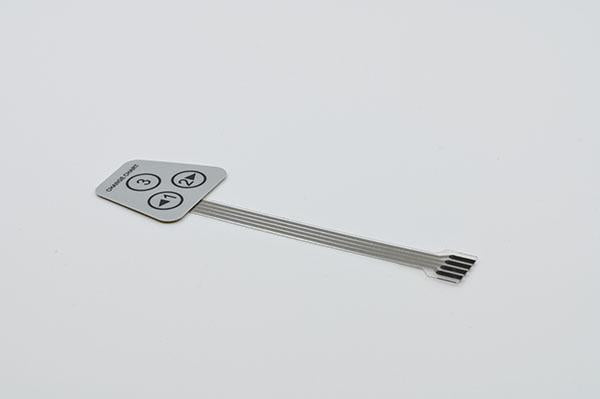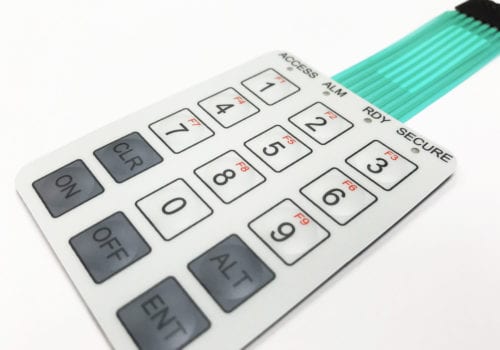Top Applications for Membrane Switches in Consumer Electronics
Top Applications for Membrane Switches in Consumer Electronics
Blog Article
Recognizing the Value of Membrane Switches in User User Interfaces
Membrane buttons are essential components in the style of effective interface, helping with not only performance yet likewise enhancing aesthetic allure and individual communication. Their special features, such as resistance to ecological variables and adjustable designs, make them appropriate for a varied array of applications throughout multiple markets. As we explore the different benefits and future trends connected with Membrane modern technology, it ends up being clear that these buttons are more than simply components; they stand for a convergence of technology and functionality. The implications of this modern technology on individual experience are worth analyzing better.
What Are Membrane Buttons?

The spacer layer, which has glue properties, permits for the splitting up of the circuit layer from the overlay, making sure that the switch remains in a non-activated state until pushed. When pressure is applied to the overlay, it presses the spacer layer, connecting the space and completing the circuit in the underlying layer. This layout not just decreases the physical space needed for standard mechanical switches yet likewise enhances the durability of the device, as Membrane buttons are typically resistant to dirt, wetness, and other ecological elements.
Generally discovered in applications ranging from customer electronics to clinical gadgets, Membrane switches are integral to modern-day technology, providing a reliable and easy to use interface that lines up with contemporary style requirements.
Benefits of Membrane Switches
While countless switch modern technologies exist, Membrane Switches deal distinct benefits that make them specifically desirable in numerous applications. One of the main advantages of Membrane buttons is their portable design, which permits for space-saving applications in tools where property is restricted. Their slim account not only improves aesthetic charm yet also assists in light-weight construction.
An additional substantial benefit is their resistance to environmental aspects. Membrane switches are normally secured against wetness, dirt, and impurities, making them ideal for usage sought after atmospheres, such as clinical tools and commercial equipment. This sturdiness expands the life-span of the switch, decreasing upkeep prices and boosting reliability.
Furthermore, Membrane switches can be personalized to satisfy details layout needs, incorporating special graphics and shades that boost user interaction. Their tactile feedback options can also be tailored to provide a rewarding user experience. In addition, Membrane buttons are cost-efficient, specifically in high-volume applications, as they can be generated successfully.
Applications in Different Industries

In the consumer electronics field, Membrane buttons prevail in devices such as microwaves, washing equipments, and push-button controls. Their tactile responses and aesthetic options boost user experience while giving a smooth, modern appearance. Additionally, vehicle makers utilize Membrane switches in control panel controls and infotainment systems, where room is limited, and individual engagement anchor is essential.
Furthermore, the commercial industry leverages Membrane buttons in control panels for machinery and tools, allowing for instinctive operation in commonly harsh atmospheres. Their resistance to chemicals and moisture guarantees long life and reliability in these applications. Generally, the adaptability of Membrane Switches adds considerably to their prevalent use, making them vital in various technological domain names.
Layout Considerations for Membrane Buttons

When developing Membrane buttons, numerous crucial considerations have to be considered to make sure optimal performance and customer experience. The selection of products is essential; picking sturdy, high-quality substrates can enhance the button's long life and resistance to ecological variables such as dampness and temperature level changes.
Second of all, the style of the graphic overlay ought to prioritize clarity and convenience of usage. Symbols and text should be legible, and the layout needs to assist in instinctive interaction (membrane switches). Furthermore, tactile responses is crucial; including a tactile dome or other devices can boost the individual visit experience by offering physical verification of activation
An additional essential element is the switch's electric efficiency. Designers must make certain that the conductive traces are appropriately created official statement to minimize resistance and stay clear of signal disturbance. This involves analyzing the called for actuation pressure and guaranteeing compatibility with the digital elements they will user interface with.

Future Patterns in Membrane Innovation
As modern technology remains to breakthrough, Membrane buttons are poised to progress significantly, driven by technologies in materials and producing strategies. One emerging trend is the incorporation of sophisticated products, such as flexible substrates and conductive inks, which boost resilience and minimize the total weight of Membrane switches. These products not just improve the tactile feedback but likewise enable the layout of switches that can endure harsher ecological problems.
Furthermore, the combination of touch-sensitive modern technologies is transforming conventional Membrane Switches right into even more interactive interface. Capacitive touch sensors embedded within Membrane switch panels can supply an extra intuitive and responsive individual experience, straightening with the expanding need for streamlined, modern designs in consumer electronics.
Furthermore, improvements in printing methods, such as electronic and 3D printing, make it possible for quick prototyping and modification of Membrane buttons. This adaptability allows producers to respond a lot more swiftly to market demands and consumer preferences.
Finally, sustainability is ending up being a considerable focus, with producers exploring environmentally friendly materials and processes. As these patterns unfold, the future of Membrane technology promises enhanced capability, visual charm, and environmental responsibility, solidifying their duty in innovative interface across various industries.
Conclusion
Finally, Membrane Switches represent an essential part in the style of user interfaces, combining capability with aesthetic flexibility. Their benefits, consisting of sturdiness and resistance to environmental factors, make them ideal for varied applications across numerous markets. Thoughtful design factors to consider improve user communication and experience. As developments in modern technology continue, the evolution of Membrane switches is anticipated to further improve interface, driving technology and enhancing usability in a progressively complex technical landscape.
Membrane switches are essential parts in the design of efficient individual interfaces, facilitating not only performance yet also improving visual allure and user interaction.Membrane Switches offer as a vital component in different individual interfaces, promoting a seamless interaction between individuals and digital tools.While countless switch technologies exist, Membrane Switches offer unique benefits that make them particularly desirable in various applications.Furthermore, Membrane switches can be personalized to meet certain style needs, including one-of-a-kind graphics and colors that enhance user interaction.In conclusion, Membrane Switches stand for a vital element in the style of user interfaces, incorporating functionality with aesthetic versatility.
Report this page